DoorDash Bundle
How Did DoorDash Dominate the Food Delivery Market?
In the cutthroat world of on-demand delivery, DoorDash's ascent to the top is a masterclass in strategic execution. Its expansion beyond restaurants into groceries and retail, combined with a laser focus on data-driven decision-making, has fueled its remarkable growth. Understanding DoorDash's DoorDash SWOT Analysis is crucial to grasping the intricacies of its success.
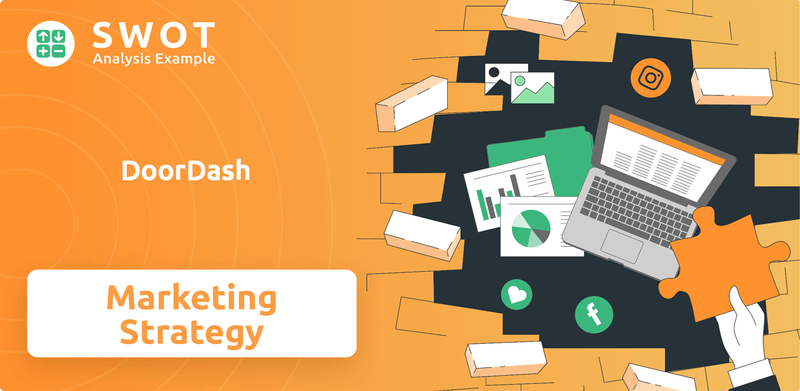
This exploration delves into the core of DoorDash's success, dissecting its innovative DoorDash sales strategy and dynamic DoorDash marketing strategy. We'll uncover the tactics behind its impressive market share, examining its DoorDash business model, customer acquisition strategies, and the key marketing campaigns that have propelled it to the forefront of the food delivery service marketing landscape. From online food ordering sales techniques to delivery app marketing innovations, discover how DoorDash continues to thrive.
How Does DoorDash Reach Its Customers?
The sales channels of DoorDash are primarily centered around its digital platform, which includes its website (doordash.com) and the mobile application. These platforms serve as the main interface connecting customers with a variety of local businesses, such as restaurants, grocery stores, and other retailers. The company's strategy focuses on expanding its offerings and forming strategic partnerships to increase its market share and customer base.
In Q1 2024, the DoorDash app had over 39 million monthly active users by March, showing consistent growth since December 2023. The website also saw a steady increase in visits, reaching over 240 million in March 2024. This digital presence is crucial for the company's sales and marketing efforts, enabling it to reach a wide audience and provide a seamless ordering experience.
DoorDash's sales strategy is significantly influenced by its ability to innovate and adapt to changing consumer behaviors. The company has expanded into new verticals like grocery and convenience store delivery to diversify its revenue streams. By December 2024, monthly active users reached an all-time high of over 42 million, a rise from over 37 million in December 2023, driven in part by improvements to merchant selection and the breadth of categories offered.
DoorDash heavily relies on its digital platforms, including its website and mobile app, as the primary sales channels. These channels connect customers with local businesses, facilitating online ordering and delivery services. The user-friendly interface and extensive reach of these platforms are central to DoorDash's growth strategy.
Key partnerships with local and national restaurants, grocery stores, and other retailers are crucial to DoorDash's sales strategy. These collaborations expand the variety of options available to customers and enable DoorDash to tap into existing customer bases. These partnerships have helped DoorDash achieve a 67% market share in the U.S. food delivery service market as of March 2024.
DoorDash has strategically expanded into new verticals such as grocery and convenience store delivery to diversify its revenue streams and meet evolving consumer needs. This expansion has contributed to increased user engagement and market share. Over 25% of DoorDash's monthly active users in December 2024 ordered from at least one new verticals category, a rise from over 20% in December 2023.
The acquisition of Wolt in 2022 expanded DoorDash's international footprint, adding 23 new markets in Europe. This global expansion allows DoorDash to reach new customer segments and increase its overall market presence. International operations represent a significant growth opportunity for the company.
DoorDash's sales strategy focuses on its digital platform, strategic partnerships, and expansion into new verticals. These elements work together to drive customer acquisition and revenue growth. The company's ability to adapt to market changes and leverage its existing infrastructure is key to its success.
- Digital Platform: The DoorDash website and app are the primary sales channels, providing a seamless ordering experience.
- Strategic Partnerships: Collaborations with restaurants, grocery stores, and other retailers expand offerings and reach new customers.
- New Verticals: Expansion into grocery and convenience store delivery diversifies revenue streams and caters to changing consumer preferences.
- International Expansion: The acquisition of Wolt has expanded DoorDash's presence in Europe.
DoorDash SWOT Analysis
- Complete SWOT Breakdown
- Fully Customizable
- Editable in Excel & Word
- Professional Formatting
- Investor-Ready Format
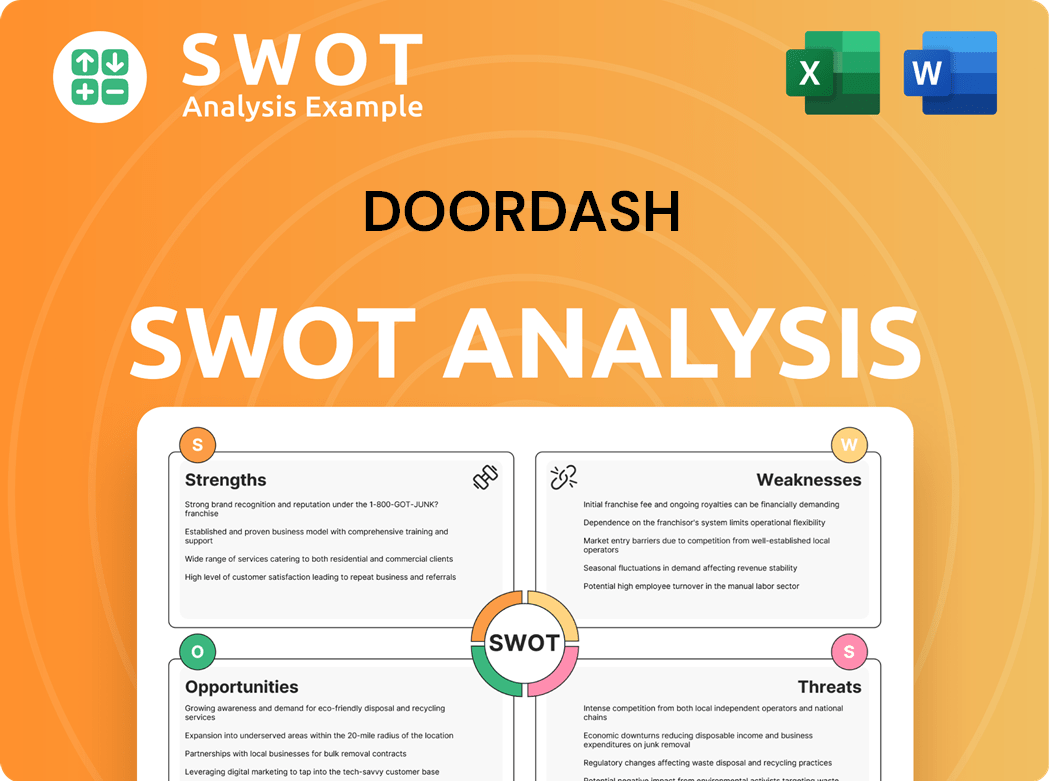
What Marketing Tactics Does DoorDash Use?
The [Company Name] employs a multifaceted marketing strategy focused on digital channels to boost brand visibility, attract new customers, and drive sales. This approach includes a mix of content marketing, search engine optimization (SEO), and paid advertising. The company's digital-first strategy is central to its overall business model.
A significant portion of [Company Name]'s marketing budget is allocated to digital advertising, with a strong emphasis on performance-driven campaigns. They utilize various platforms, including social media and over-the-top (OTT) platforms, to reach a wide audience. [Company Name] also leverages in-app advertising solutions and promotional offers to incentivize customer orders and boost sales.
Data-driven marketing, customer segmentation, and personalization are key components of [Company Name]'s strategy. They use customer surveys, data analysis, and market research to understand user preferences and tailor marketing efforts. This approach enables them to create targeted campaigns and promotions, enhancing customer loyalty and driving growth.
Digital marketing is a cornerstone of [Company Name]'s strategy, with significant investment in channels like Facebook and TikTok. They utilize Digital Out Of Home (DOOH) advertising, partnering with Vistar for performance-driven campaigns.
They offer in-app advertising solutions, where merchants pay only when an ad leads to an order. Promotions are used to incentivize customer orders and increase sales, driving revenue for both the company and its partners.
Customer surveys, data analysis, and market research are used to understand user preferences and behaviors. The 'DoorDash Customer 360 Data Store' supports targeting and personalized customer experiences, crucial for customer loyalty.
Marketing campaigns and promotions are tailored to specific audience segments. This approach helps [Company Name] understand customer needs and provide tailored experiences, which is crucial for customer loyalty.
They leverage DOOH for Dasher recruitment and continuously update the app and website based on customer feedback. This allows for real-time adjustments in media planning and buying tactics.
In 2023, [Company Name] spent $1.88 billion on sales and marketing, with $504 million spent in Q1 2024. This indicates a continued significant investment in brand promotion and customer acquisition.
The [Company Name] sales strategy and marketing efforts are continually refined through data analysis and customer feedback. They also utilize experimental strategies, such as leveraging Digital Out Of Home (DOOH) advertising for Dasher recruitment. This allows them to adjust media planning and buying tactics in real-time. These tactics are crucial for the company's growth strategy.
The company's marketing tactics are heavily reliant on digital strategies, including content marketing, SEO, and paid advertising. The company's monthly advertising spend varied in Q1 2024, with a peak in December 2023 at over $16 million. Over 45% of orders generated from ads come from new customers.
- Digital advertising campaigns are frequently optimized based on performance metrics.
- In-app advertising provides merchants with a pay-per-order model, enhancing their return on investment. Businesses, on average, earn $6 for every $1 spent on ads over one month.
- Customer data is used to create targeted campaigns, enhancing customer engagement and loyalty.
- The company's approach to DoorDash sales and marketing tactics includes continuous improvement of the user experience.
DoorDash PESTLE Analysis
- Covers All 6 PESTLE Categories
- No Research Needed – Save Hours of Work
- Built by Experts, Trusted by Consultants
- Instant Download, Ready to Use
- 100% Editable, Fully Customizable
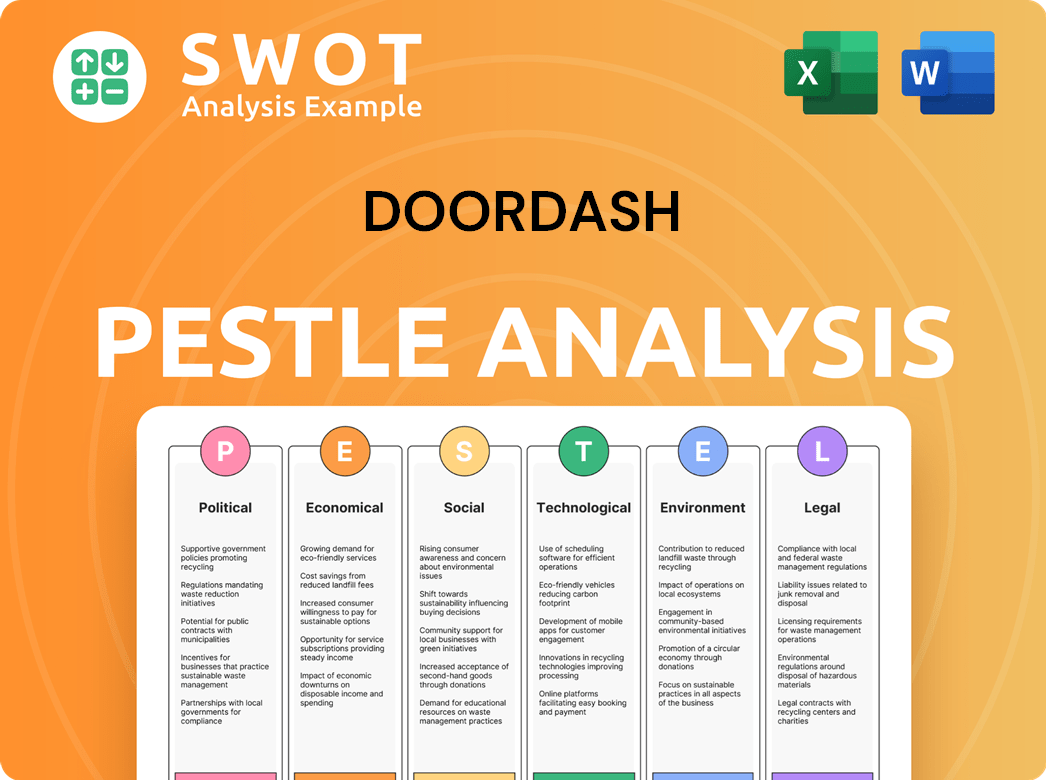
How Is DoorDash Positioned in the Market?
DoorDash strategically positions itself as a leading local commerce platform. Its core message centers on convenience, variety, and reliability, connecting consumers with merchants and delivery personnel. This approach has allowed it to become a prominent player in the competitive food delivery service marketing landscape.
The company's brand differentiation stems from its wide selection of restaurants and other businesses, coupled with an efficient delivery network and a user-friendly platform. By leveraging technology, DoorDash provides valuable data to its partnered restaurants, helping them understand consumer behavior. This focus on data-driven insights is a key component of its overall DoorDash sales strategy.
DoorDash's target audience includes busy professionals, families, and health-conscious individuals, catering to their diverse needs for convenient food and item delivery. The platform also empowers restaurants by offering them the opportunity to reach a wider audience and increase sales. For example, restaurants running promotions on the platform saw an average sales increase of 20% in a 2020 case study.
DoorDash emphasizes convenience and variety in its marketing. The platform offers a wide selection of restaurants and other businesses. This allows customers to easily find and order what they want.
Reliability is a key aspect of DoorDash's brand. The company focuses on providing efficient and dependable delivery services. This helps build customer trust and loyalty.
DoorDash leverages technology to provide advanced data to its partners. This data helps restaurants understand consumer behavior. It also helps them improve the customer experience.
The platform aims to empower local economies by connecting consumers with local businesses. This strategy supports local merchants and helps them increase their sales. This is a core part of its DoorDash business model.
DoorDash consistently maintains brand consistency across its channels. The brand's recognition is strong and perceived as purposeful. It adapts to competitive threats by expanding into new markets and diversifying services.
- User-Friendly Platform: The app is easy to navigate, making ordering simple.
- Wide Selection: Offers a variety of restaurants and stores.
- Efficient Delivery Network: Focuses on speed and reliability.
- Data-Driven Insights: Provides valuable data to partners.
DoorDash Business Model Canvas
- Complete 9-Block Business Model Canvas
- Effortlessly Communicate Your Business Strategy
- Investor-Ready BMC Format
- 100% Editable and Customizable
- Clear and Structured Layout
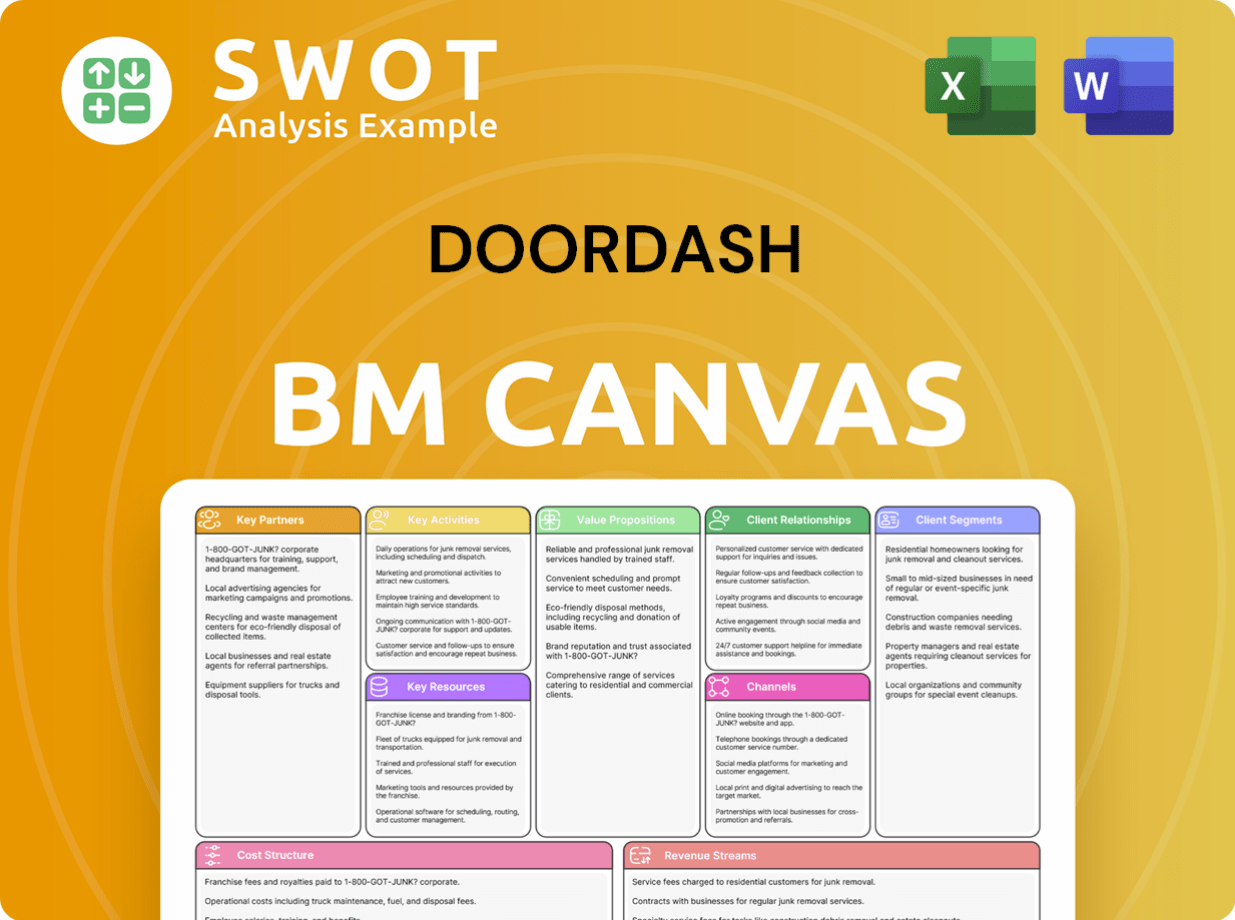
What Are DoorDash’s Most Notable Campaigns?
The sales and marketing strategy of the company revolves around several key campaigns designed to drive growth and maintain its market position. These campaigns are not always explicitly named but are ongoing strategic initiatives. The company continually evolves its approach to customer acquisition, retention, and expansion into new markets. This strategy is crucial for the company to stay competitive in the dynamic food delivery and broader e-commerce landscape.
A core element of the company's approach involves leveraging its existing infrastructure and brand recognition to enter new verticals. This involves expanding its offerings beyond its core restaurant delivery service. The company strategically uses promotions, advertising, and subscription services to increase customer engagement and order frequency. The company's ability to adapt and innovate in its marketing efforts is central to its continued success and ability to capture a larger share of the market.
The company's marketing efforts are multifaceted, focusing on both customer acquisition and retention. These efforts involve a blend of digital marketing, promotional campaigns, and strategic partnerships. The company's ongoing initiatives are designed to enhance user experience, build brand loyalty, and expand its reach to new customers and markets. To learn more about their overarching growth plan, check out this article about the Growth Strategy of DoorDash.
A major ongoing campaign involves expanding into new verticals, such as grocery and retail delivery. This strategy aims to diversify offerings beyond restaurants, attracting new customers. The expansion includes adding thousands of new grocery stores to the platform. This approach contributed to a 21% year-over-year growth in Marketplace Gross Order Value (GOV) in Q4 2024, reaching $21.3 billion.
The promotion of the DashPass subscription service is another key initiative. The goal is to foster customer loyalty and increase order frequency by offering benefits like free deliveries. The success of DashPass is evident in the growth of DashPass and Wolt+ members to over 22 million by the end of 2024, up from over 18 million in December 2023. This program directly boosts customer engagement and revenue per user.
The company consistently runs promotions and advertising campaigns within its app and across digital channels. These campaigns drive sales by incentivizing customers with deals and offering prominent ad placements for merchants. Data from February to July 2022 indicated that, on average, more than 45% of orders generated from ads came from new customers.
The company invests in Digital Out Of Home (DOOH) advertising, tailoring creative messaging to highlight employment opportunities and strategically activating media in key demographic areas. The goal is to support mid-to-down funnel metrics such as conversions, lift in consideration and intent, and site visits, thereby driving sign-ups and expanding its Dasher network.
DoorDash Porter's Five Forces Analysis
- Covers All 5 Competitive Forces in Detail
- Structured for Consultants, Students, and Founders
- 100% Editable in Microsoft Word & Excel
- Instant Digital Download – Use Immediately
- Compatible with Mac & PC – Fully Unlocked
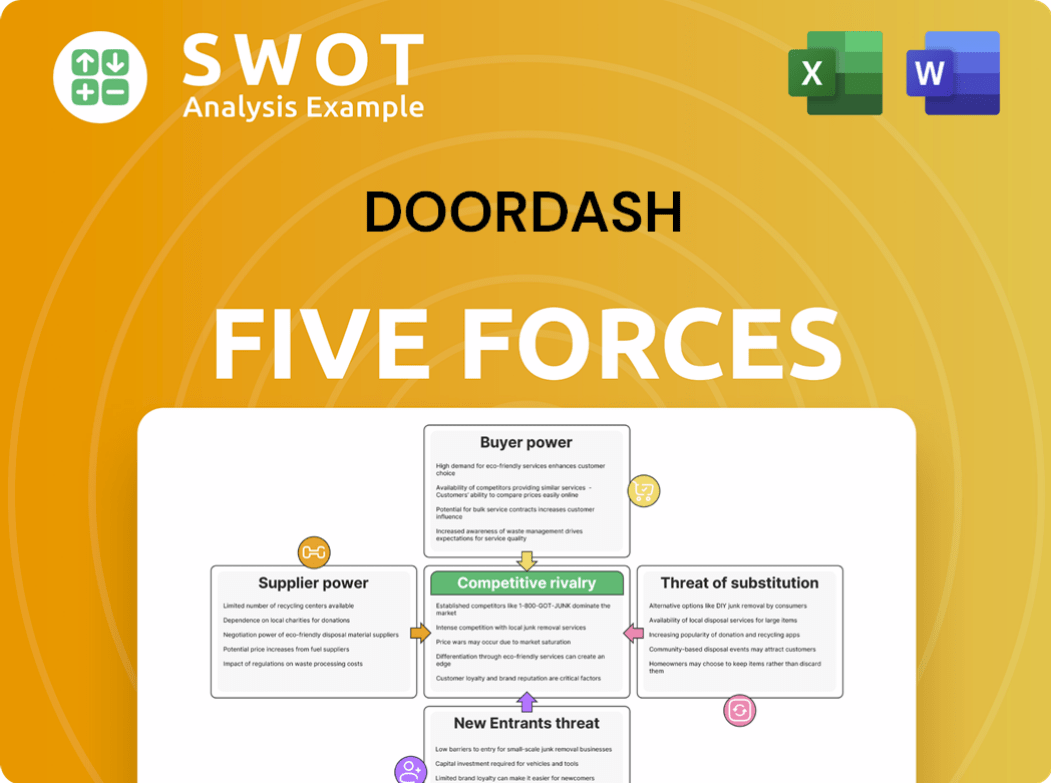
Related Blogs
- What are Mission Vision & Core Values of DoorDash Company?
- What is Competitive Landscape of DoorDash Company?
- What is Growth Strategy and Future Prospects of DoorDash Company?
- How Does DoorDash Company Work?
- What is Brief History of DoorDash Company?
- Who Owns DoorDash Company?
- What is Customer Demographics and Target Market of DoorDash Company?
Disclaimer
All information, articles, and product details provided on this website are for general informational and educational purposes only. We do not claim any ownership over, nor do we intend to infringe upon, any trademarks, copyrights, logos, brand names, or other intellectual property mentioned or depicted on this site. Such intellectual property remains the property of its respective owners, and any references here are made solely for identification or informational purposes, without implying any affiliation, endorsement, or partnership.
We make no representations or warranties, express or implied, regarding the accuracy, completeness, or suitability of any content or products presented. Nothing on this website should be construed as legal, tax, investment, financial, medical, or other professional advice. In addition, no part of this site—including articles or product references—constitutes a solicitation, recommendation, endorsement, advertisement, or offer to buy or sell any securities, franchises, or other financial instruments, particularly in jurisdictions where such activity would be unlawful.
All content is of a general nature and may not address the specific circumstances of any individual or entity. It is not a substitute for professional advice or services. Any actions you take based on the information provided here are strictly at your own risk. You accept full responsibility for any decisions or outcomes arising from your use of this website and agree to release us from any liability in connection with your use of, or reliance upon, the content or products found herein.